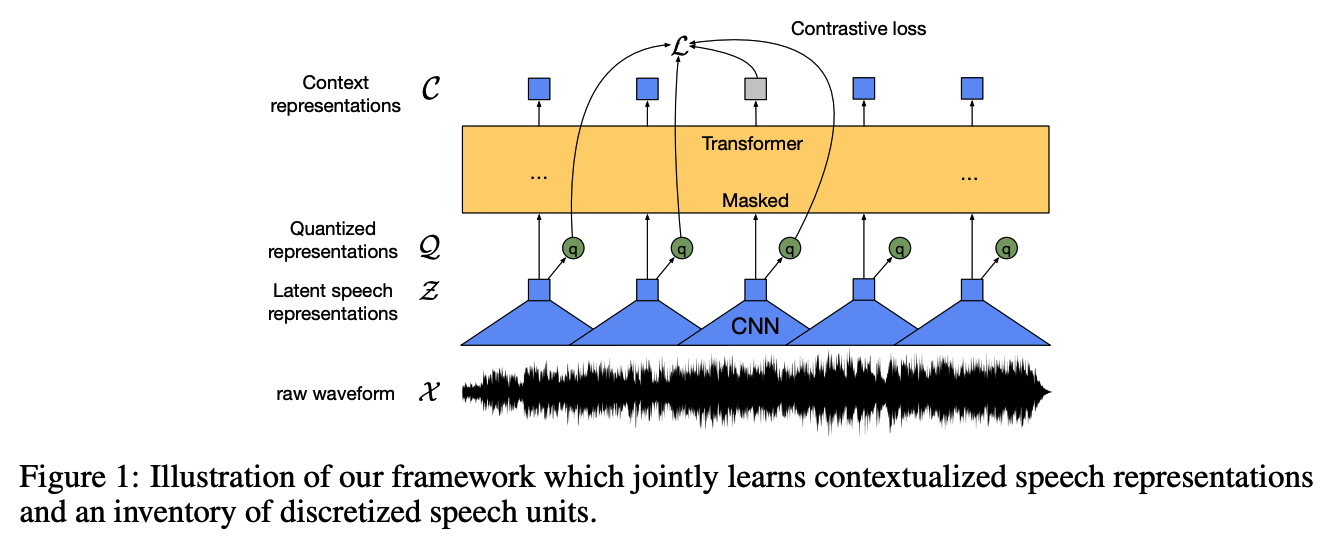wav2vec 2.0; A Framework for Self-Supervised Learning of Speech Representations ( NeurIPS 2020 )
https://arxiv.org/pdf/2006.11477.pdf
Contents
- Abstract
- Model
- Feature encoder
- Contextualized representations with Transformers
- Quantization module
- Training
- Masking
- Objective
Abstract
Learning powerful representations from speech audio alone followed by fine-tuning on transcribed speech can outperform the best semi-supervised methods!
wav2vec 2.0
- masks the speech input in the latent space
- solves a contrastive task defined over a quantization of the latent representations which are jointly learned.
1. Model

(1) Multi-layer CNN feature encoder \(f: \mathcal{X} \mapsto \mathcal{Z}\)
- input = raw audio \(\mathcal{X}\)
- output = latent speech representations \(\mathbf{z}_1, \ldots, \mathbf{z}_T\) for \(T\) time-steps.
- output is discretized to \(\mathbf{q}_t\)
- via a quantization module \(\mathcal{Z} \mapsto \mathcal{Q}\)
- to represent the targets in the self-supervised objective
- output is discretized to \(\mathbf{q}_t\)
(2) Transformer \(g: \mathcal{Z} \mapsto \mathcal{C}\)
- to build representations \(\mathbf{c}_1, \ldots, \mathbf{c}_T\) capturing information from the entire sequence
Comparison with VQ-wav2vec
- wav2vec 2.0 = builds context representations over continuous speech representations and self-attention captures dependencies over the entire sequence of latent representations end-to-end.
(1) Feature encoder
Architecture
- consists of several blocks containing a temporal convolution
- followed by LayerNorm & GeLU
- total stride of the encoder determines the number of time-steps \(T\)
- which are input to the Transformer
Input : raw waveform
- normalized to zero mean and unit variance
(2) Contextualized representations with Transformers
use Transformer as a context network
Input = output of the feature encoder
Positional embedding
- fixed positional embeddings (X)
- encode absolute positional information
- use a convolutional layer which acts as relative positional embedding (O)
(3) Quantization module
Discretize the output of the feature encoder \(\mathbf{z}\) to a finite set of speech representations via product quantization
Product quantization
- learn discrete units & then learning contextualized representations
- choosing quantized representations from multiple codebooks and concatenating them
- mulitple codebooks = \(G\) codebooks with \(V\) entries \(e \in\) \(\mathbb{R}^{V \times d / G}\)
- How?
- step 1) choose one entry from each codebook
- step 2) oncatenate the resulting vectors \(e_1, \ldots, e_G\)
- step 3) linear transformation \(\mathbb{R}^d \mapsto \mathbb{R}^f\) to obtain \(\mathbf{q} \in \mathbb{R}^f\).
- use Gubmel softmax to make it differentiable
Result :
-
\(\mathbf{z}\) is mapped to \(\mathbf{l} \in \mathbb{R}^{G \times V}\) logits
-
Probabilities for choosing the \(v\)-th codebook entry for group \(g\) are
- \(p_{g, v}=\frac{\exp \left(l_{g, v}+n_v\right) / \tau}{\sum_{k=1}^V \exp \left(l_{g, k}+n_k\right) / \tau}\).
- \(n=-\log (-\log (u))\) and \(u\) are uniform samples from \(\mathcal{U}(0,1)\).
Forward & Backward pass
- Forward pass : codeword \(i\) is chosen by \(i=\operatorname{argmax}_j p_{g, j}\)
- Backward pass : true gradient of the Gumbel softmax outputs is used
3. Training
Identifying the correct quantized latent audio representation in a set of distractors for each masked time step
(1) Masking
-
mask a proportion of the feature encoder outputs
-
replace them with a trained feature vector shared between all masked time steps
- ( of course, do not mask inputs to the quantization module )
-
masking = randomly sample without replacement a certain proportion \(p\) of all time steps to be starting indices & then mask the subsequent \(M\) consecutive time steps
( \(\therefore\) can be overlapped )
(2) Objective
a) Contrastive task \(\mathcal{L}_m\)
- identify the true quantized latent speech representation for a masked time step within a set of distractors
b) Codebook diversity loss \(\mathcal{L}_d\)
- to encourage the model to use the codebook entries equally often.
\(\rightarrow\) Final Loss : \(\mathcal{L}=\mathcal{L}_m+\alpha \mathcal{L}_d\)
a) Contrastive Loss
\(\mathcal{L}_m=-\log \frac{\exp \left(\operatorname{sim}\left(\mathbf{c}_t, \mathbf{q}_t\right) / \kappa\right)}{\sum_{\tilde{\mathbf{q}} \sim \mathbf{Q}_t} \exp \left(\operatorname{sim}\left(\mathbf{c}_t, \tilde{\mathbf{q}}\right) / \kappa\right)}\).
Goal : needs to identify the true quantized latent speech representation \(\mathbf{q}_t\)
- among a set of \(K+1\) quantized candidate representations \(\tilde{\mathbf{q}} \in \mathbf{Q}_t\)
- \(\mathbf{Q}_t\) includes \(\mathbf{q}_t\) and \(K\) distractors, wheredistractors are uniformly sampled from other masked time steps of the same utterance.
b) Diversity Loss
Contrastive task depends on the codebook
\(\rightarrow\) diversity loss \(\mathcal{L}_d\) is designed to increase the use of the quantized codebook
\(\rightarrow\) encourage the equal use of the \(V\) entries in each of the \(G\) codebooks
- by maximizing the entropy of the averaged softmax distribution \(\mathbf{1}\) over the codebook entries for each codebook \(\bar{p_g}\) across a batch of utterances
\(\mathcal{L}_d=\frac{1}{G V} \sum_{g=1}^G-H\left(\bar{p}_g\right)=\frac{1}{G V} \sum_{g=1}^G \sum_{v=1}^V \bar{p}_{g, v} \log \bar{p}_{g, v}\).
